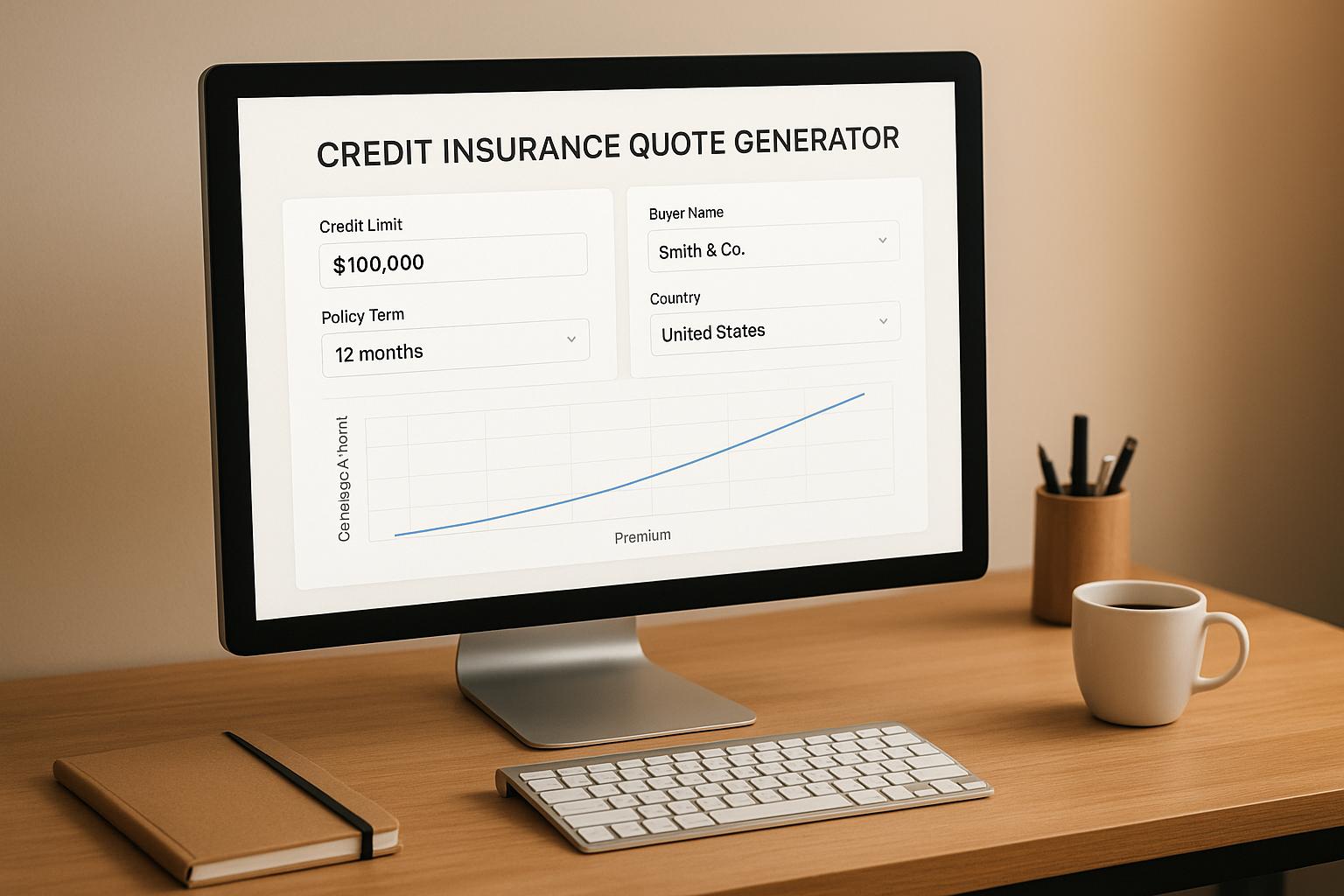Trade credit insurance protects your business from losses when customers fail to pay. Setting credit limits is a key part of this process. Here’s how it works:
- What Are Credit Limits? These are the maximum amounts your insurer will cover if a customer defaults. Limits are set for each buyer based on their financial health.
- Why Do They Matter? Credit limits reduce financial risk, help maintain cash flow, and improve your credit profile. Most policies cover up to 90% of outstanding debt within approved limits.
- How Are They Set? Insurers assess buyers using financial data, payment history, and industry risks. You submit credit limit requests with supporting documents like financial statements and credit reports.
- Managing Credit Limits: Regularly monitor buyer risk, adjust limits as needed, and document approvals. Use policy renewals to reassess and update limits.
Key Tip: Align credit limits with your business strategy to balance growth opportunities and risk management. Always keep detailed records and stay proactive in monitoring customer financial health.
What is the ‘maximum aggregate credit limit amount’ on my policy? Atradius UK
Steps to Set Credit Limits Under Trade Credit Insurance
Establishing credit limits under trade credit insurance involves a structured approach that balances risk and business growth. Each step, from evaluating customer creditworthiness to documenting approvals, plays a key role in aligning your insurance coverage with your business relationships. This process is an integral part of your broader risk management strategy.
Evaluate Customer Creditworthiness
Before requesting a credit limit, it’s essential to thoroughly assess your customer’s financial health and payment reliability. This evaluation is the cornerstone of your credit limit strategy and directly impacts your insurer’s decision.
A good starting point is analyzing the five C’s of creditworthiness:
| Factor | Description |
|---|---|
| Character | Trustworthiness and reputation for sound business practices |
| Capacity | Ability to pay invoices based on cash flow |
| Collateral | Assets that can be liquidated to settle debt |
| Capital | How well-capitalized the business is |
| Conditions | External factors like economic and political situations affecting the business |
Dive into financial statement analysis by reviewing certified financial and cash flow statements from your buyers. This includes examining debt-to-income ratios to gauge their ability to meet payment obligations. If available, incorporate credit reports and business credit scores – scores above 75 are generally considered strong.
For a systematic approach, use a business credit application form to collect all relevant details. If you’re working with international buyers, don’t overlook regional and political risks, such as currency stability and local economic factors, which could impact their ability to pay.
Submit Credit Limit Requests to Your Insurer
Once you’ve evaluated your buyer’s creditworthiness, the next step is to formally request a credit limit through your insurer’s platform. Many insurers offer online tools to streamline this process.
Prepare your documentation thoroughly. Include financial statements, credit reports, and your internal assessment of the buyer’s creditworthiness. The quality of your submission can significantly influence the insurer’s decision.
When deciding on the credit limit amount, consider the maximum amount your buyer might owe at any given time. This should account for all outstanding invoices, not just individual transactions. Think about your typical order sizes, payment terms, and how frequently you expect transactions to occur.
To strengthen your case, provide details about your trading history with the buyer. Highlight how long you’ve been working together, the usual transaction volumes, and any specific terms or conditions that apply to your relationship. This additional context helps insurers see the bigger picture beyond just the numbers.
Understand the Insurer’s Evaluation Process
Insurers use various tools and techniques to assess credit limit requests. Understanding their approach can help you prepare better submissions and set realistic expectations.
Underwriters rely on multiple data sources, including financial statements, public records, reports from other policyholders, and even direct communication with the buyer. This comprehensive review ensures they have a well-rounded view of the buyer’s creditworthiness.
Other factors, such as buyer limit capacity and the insurer’s overall exposure, can influence decisions. Even financially strong buyers may receive lower limits if the insurer needs to manage its risk exposure.
Insurers also consider economic conditions and industry factors. Businesses in higher-risk industries often face stricter scrutiny and may receive lower limits or higher premiums. Decisions typically result in full approval, partial approval, or denial, each accompanied by an explanation to help you address any issues for future requests.
Review and Document Approved Credit Limits
Proper documentation of approved credit limits is crucial for smooth operations and claims processing. This step is often overlooked but becomes critical during audits or claim situations.
Keep detailed records of all approved credit limits, including the limit amount, approval date, any special conditions, and renewal dates. A centralized tracking system can make it easier to manage this information for each buyer.
Understand the distinction between cancelable and non-cancelable credit limits. Cancelable limits can be withdrawn by the insurer with notice, while non-cancelable limits provide stability throughout the policy period.
Regularly monitor limit utilization to ensure you’re operating within the approved parameters. Approved credit limits represent the maximum insured coverage for each buyer, allowing you to trade confidently without needing further approvals during the policy period.
Set reminders for renewals to avoid coverage gaps. Insurers monitor buyers’ creditworthiness on an ongoing basis, and you should do the same to minimize risks.
Lastly, factor in the costs associated with credit limits, such as fees for administration, credit limits, or debt collection services. These expenses should be considered in your overall risk management budget and pricing strategies.
Key Factors That Influence Credit Limit Decisions
When insurers evaluate credit limit requests, they consider several factors that directly impact the likelihood of payment default. By understanding these elements, you can better prepare your applications and set realistic expectations for credit limit approvals. These factors are essential in shaping an insurer’s decision-making process.
Buyer Financial Health and Payment History
Insurers closely examine a buyer’s financial health through their balance sheet, income statement, and cash flow. They pay particular attention to key financial ratios, which are grouped into three main categories:
| Category | Key Ratios | What It Measures |
|---|---|---|
| Liquidity Ratios | Current Ratio, Quick Ratio, Cash Flow Coverage | A buyer’s ability to meet short-term obligations using current assets |
| Profitability Ratios | Net Profit Margin, Return on Assets (ROA), Return on Equity (ROE) | A buyer’s ability to generate earnings relative to sales, assets, or equity |
| Solvency Ratios | Debt-to-Equity Ratio, Debt-to-Assets Ratio, Interest Coverage Ratio | Long-term financial stability and capacity to manage debt |
Payment history is another critical factor. According to Experian, it accounts for 35% of a FICO credit score, making it the most important component in assessing creditworthiness.
"Creditworthiness is a measure of how likely you will default on your debt obligations according to a lender’s assessment, or how worthy you are to receive new credit." – Experian
Insurers also gather feedback from trade references – real-world insights from businesses that have extended credit to the buyer. This additional layer of information helps insurers evaluate how well buyers manage their payment obligations beyond what financial statements reveal.
Industry and Market Risk
The industry a buyer operates in and overall market conditions significantly influence credit limit decisions. Insurers monitor industries that are more prone to volatility or economic challenges. These sectors often face stricter credit limits or additional conditions due to the heightened risk.
For example, corporate defaults and insolvency account for 25% of corporate bankruptcies, highlighting the importance of industry risk assessments. Broader economic factors, such as slower global GDP growth, supply chain shifts, and geopolitical tensions, add layers of uncertainty that insurers must consider.
Highly competitive industries also pose unique risks. Price pressures in these markets can erode profitability, making it harder for buyers to meet payment obligations. As a result, insurers often take these dynamics into account when setting credit limits.
Given the current economic climate, there is an expectation of increased corporate insolvencies. This has prompted insurers to adopt a more cautious approach, especially for industries experiencing stress or cyclical downturns.
Transaction Size and Frequency
The size and frequency of transactions with a buyer play a direct role in credit limit decisions. Insurers assess both the maximum potential exposure at any point in time and the regularity of transactions. These patterns are analyzed to ensure they align with the buyer’s cash flow and payment capabilities.
Frequent, smaller transactions in established trading relationships are often viewed more favorably than large, one-off requests from newer buyers. Additionally, the interaction between payment terms and transaction size is crucial. Buyers with shorter payment cycles (e.g., 30 days) may qualify for higher limits compared to those with longer terms (e.g., 90 days), as shorter cycles reduce the risk of delayed payments.
Geographic and Political Risks
For U.S. businesses operating internationally, geographic and political risks are key considerations in credit limit decisions. Insurers assess a country’s stability, including governance, security, and climate-related concerns.
Coface, a leading trade credit insurer, evaluates 160 countries year-round to provide risk scores based on political and social stability. These scores directly influence the credit limits available for buyers in different regions.
"After more than 70 years of peace, political risk has been back in the forefront, in various forms, and has punctuated the agenda of many countries in recent years. These risks are clearly on the increase, notably due to the reshaping of the world order and the climate emergency, two major sources of uncertainty and instability for the years to come." – Ruben NIZARD, North America Economist and Head of Political Risk at Coface
Factors such as government interference, civil unrest, sanctions, and climate risks can lead to reduced credit limits, even for financially stable buyers. Additionally, currency volatility adds another layer of risk. Buyers operating in regions with unstable currencies may face lower limits due to the potential for devaluation impacting their ability to pay in U.S. dollars.
sbb-itb-2d170b0
Best Practices for Managing Credit Limits
Once you’ve set credit limits, managing them effectively is key to maintaining strong protection under trade credit insurance. This involves weaving credit limits into your credit policy, keeping an eye on customer risk, making timely adjustments, and using policy renewals as a chance to reassess your coverage.
Incorporate Credit Limits into Your Credit Policy
Credit limits are most effective when they’re part of your broader credit policy. This means clearly defining the conditions, obligations, and roles involved in credit transactions. Spell out who on your team is responsible for managing credit limits and create clear steps for handling requests to exceed approved limits.
Decide when it makes sense to request additional coverage or when small uncovered exposures can be managed. Once these processes are in place, make it a habit to regularly review and adapt your limits based on changes in customer risk.
Keep a Close Eye on Buyer Risk
Your customers’ financial situations can change, and your credit limits should reflect that. Tools like real-time monitoring systems can help you spot shifts in customer behavior, such as overdue invoices from clients who usually pay on time.
Leverage technology like AI-driven credit analysis to review updated credit reports and uncover trends that might go unnoticed during manual checks. Pull data from trusted sources like S&P and Edgar filings, and set up early warning systems to catch changes in credit ratings or industry conditions before they impact your business.
Adjust Limits as Circumstances Change
Regularly monitoring risk is only useful if you act on what you learn. Reevaluate credit limits at least twice a year or whenever major changes occur in a customer’s financial health.
For example, during the economic uncertainty of the 2020 coronavirus pandemic, trade credit insurers reduced coverage to address rising concerns about unpaid invoices. Similarly, if a customer’s financial outlook improves, consider requesting higher limits to support more business. On the flip side, if risks start to emerge, you might lower limits or seek additional guarantees to protect your business while maintaining the relationship.
Always document any changes you make, along with the reasoning behind them, to help with future decisions and discussions with your insurer.
Reassess Limits During Policy Renewals
Annual policy renewals are a perfect opportunity to review all your credit limits using the past year’s data. These reviews build on earlier adjustments and help fine-tune your approach. For instance, customers who consistently pay early might warrant higher limits, while those with frequent late payments may need stricter thresholds.
Think about whether your current limits match your business needs. If reliable customers are constantly hitting their limits, it might be time to raise them to support growth. Conversely, limits that are rarely used could signal that a lower threshold is more appropriate.
When negotiating renewals with your insurer, share these insights to ensure your credit limits align with your business goals, market conditions, and risk tolerance.
How Accounts Receivable Insurance Supports Credit Limit Management
Accounts Receivable Insurance (ARI) plays a key role in credit limit management by combining expert insights, in-depth risk analysis, and proven strategies. These tools help businesses set credit limits with greater confidence and align them with their unique needs. ARI integrates seamlessly with established credit management practices, offering a tailored approach to managing risks and supporting growth.
Customized Credit Limit Strategies
ARI adapts credit limit strategies to match the specific needs and market focus of each business. Whether your operations are local or expanding into international markets, ARI develops plans that reflect your risk tolerance and growth goals.
From whole turnover policies to single-buyer coverage, ARI offers the flexibility to design credit limits that fit your business model – no need to compromise with a one-size-fits-all solution. This adaptability is particularly valuable, as ARI can cover up to 90% of invoice values when customers fail to pay. Considering that accounts receivable often make up 40% of a company’s total assets, this financial protection can be a game-changer.
"With accounts receivable insurance, we don’t have to ask for cash up front or payment on delivery, which makes us much more competitive." – Ori Ben-Amotz, Chief Financial Officer of Hadco
This advantage allows businesses to offer more appealing payment terms while staying within insurer-approved credit limits. Instead of requiring letters of credit or prepayments, companies can extend credit confidently, knowing they are backed by ARI.
Detailed Risk Assessments
Strong credit limit management depends on thorough risk assessments, and ARI excels in evaluating customer financial health. Trade credit insurers maintain visibility into millions of buyer relationships and transactions, providing businesses with valuable insights.
ARI evaluates current financials, market trends, and overall conditions to assess credit risks. Using advanced credit scoring techniques and real-time monitoring, ARI delivers a complete picture of customer creditworthiness, even as circumstances shift.
In 2020, 14.52% of global trade was protected by credit insurance, highlighting the growing reliance on professional risk analysis. With accounts receivable often representing 40% of a company’s total assets, this level of detailed evaluation is crucial for maintaining financial stability.
Continuous monitoring allows businesses to adjust credit limits as customer situations evolve. For example, a multinational chemical supplier entering emerging markets used ARI’s blend of financial analysis and market intelligence to reduce default losses by 20% while expanding its market presence.
Expert Claims Management
When credit challenges arise, ARI’s claims management expertise steps in to complete the risk management process. If credit limits are exceeded or payment issues occur, ARI provides a reliable financial safety net, covering up to 95% of unpaid trade receivables for both domestic and international transactions.
More than just reimbursement, ARI’s claims management involves proactive measures like adjusting credit terms and early intervention to reduce risks.
"Accounts receivable insurance has allowed us to take on customers and transactions we wouldn’t have felt comfortable taking on by ourselves… It has not only allowed my company to take on larger deals, but be more liberal in terms, and the result has gone straight to our bottom line." – Mike Libasci, President of International Fleet Sales
Additionally, ARI’s claims management enhances borrowing capacity by improving lender confidence, making it easier to access loans and financing. The process not only speeds up reimbursements but also reduces risks tied to human error, ensuring financial stability. With a responsive team in place, businesses can recover losses efficiently and stay on track for growth.
Key Takeaways for Setting Credit Limits
Establishing credit limits under trade credit insurance requires a thoughtful and structured approach. It’s about finding the right balance between seizing growth opportunities and managing potential risks. By following a clear process of evaluation, monitoring, and adjustment, businesses can safeguard their finances while staying competitive.
Summary of the Process
The first step involves assessing each customer’s financial health, payment history, and overall creditworthiness. Once you’ve gathered this information, submit detailed credit limit requests to your insurer. These requests are then evaluated based on specific criteria, and the approved limits, along with any conditions, should be documented clearly.
Kirk Elken, Co-founder of Securitas Global Risk Solutions, highlights the importance of this step:
"Approved buyer credit limits are critical. Financial and credit information drive the underwriting process".
Regularly reviewing credit limits ensures they remain appropriate as market conditions and customer circumstances evolve. This proactive approach not only minimizes risk but also helps you leverage the benefits of trade credit insurance effectively.
Using Insurance for Risk Protection
Trade credit insurance isn’t just about covering potential losses – it’s a proactive tool for managing credit risk. With affordable premiums and broad invoice coverage, it plays a vital role in protecting businesses. In fact, a large portion of global trade is backed by credit insurance, highlighting its value in today’s market.
When integrated thoughtfully into your credit policy, insurance becomes more than a safety net. It can serve as a forecasting tool, provide leverage in negotiations, and act as a protective barrier against unexpected customer defaults. As ARI Global explains:
"When used as more than a checkbox, trade credit insurance transforms from a fallback into a forecasting tool, a negotiation edge, and a shield against customer collapse. The best players aren’t just covering losses: they’re outmaneuvering them".
This strategy allows businesses to offer attractive payment terms without compromising financial security. Moreover, it signals to clients that your company takes credit management seriously, which can discourage unreliable buyers from engaging with you in the first place.
Next Steps for Businesses
To incorporate credit limits into your business strategy effectively, consider these actionable steps:
- Align Credit Limits with Your Policy: Integrate the evaluated credit limits into your existing credit policy to maintain steady cash flow. As Allianz Trade points out:
"A credit policy helps maintain a healthy cash flow".
- Monitor Continuously: Set up systems to track customer financial health and payment behavior. Early detection of issues allows you to make adjustments, such as revising terms or modifying orders, as Tim Keane, Credit & Collections Pro, suggests:
"may make a change to the terms or change up their order".
- Reassess During Policy Renewals: Use policy renewal periods to review your credit limit portfolio. This ensures your limits remain aligned with your business goals and risk tolerance.
For tailored strategies, consider working with expert services like Accounts Receivable Insurance. They offer customized approaches, detailed risk assessments, and claims management to help optimize your credit limit strategy for long-term success.
FAQs
How can I determine the right credit limits for my customers under trade credit insurance?
To determine suitable credit limits for your customers under trade credit insurance, start by assessing their creditworthiness using the "5 Cs of Credit" framework:
- Character: Look into the customer’s payment history, business reputation, and references to gauge reliability.
- Capacity: Evaluate their cash flow and debt-to-income ratio to confirm they can meet their financial obligations.
- Collateral: Identify any assets they could use to secure the credit.
- Capital: Review their financial statements to get a clear picture of their overall financial health.
- Conditions: Factor in external elements like economic trends and the stability of their industry that might affect their ability to pay.
Keeping this evaluation up-to-date is key to reducing risks and ensuring your credit limits reflect the current financial standing of your customers. For a more tailored approach, trade credit insurance providers, such as Accounts Receivable Insurance, offer support with risk assessments and customized policies designed to protect your business from non-payment and other financial uncertainties.
What should I do if my insurer denies a credit limit request for a specific buyer?
If your insurer turns down a credit limit request for a buyer, the first step is to carefully review the denial notice. Insurers usually outline the reasons for their decision, which can help you pinpoint any gaps or concerns they’ve identified.
Once you understand the reasoning, gather all relevant documents that could support your case. This might include the buyer’s financial statements, credit reports, or any other evidence that demonstrates their creditworthiness. Use this information to formally appeal the decision with your insurer, making sure to follow their procedures and include all required details to strengthen your argument.
If your appeal doesn’t succeed, it might be time to seek advice from a financial advisor or a trade credit insurance expert. They can help you assess your options and develop a plan. You may need to reconsider your credit terms with the buyer or explore alternative ways to safeguard your business against potential risks.
How does trade credit insurance help me offer better payment terms to international customers?
Trade credit insurance provides businesses with the confidence to offer favorable payment terms to international customers while minimizing financial risks. It acts as a safeguard against non-payment due to factors like bankruptcy, delayed payments, or political unrest, ensuring your cash flow stays steady.
With this type of coverage, you can pursue opportunities in new markets and expand your customer base without the looming concern of unpaid invoices. This layer of protection not only supports your growth but also helps maintain your financial stability in an increasingly competitive landscape.





